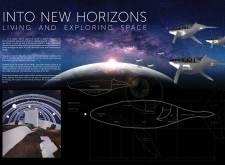5 key facts about this project
The structure is divided into several functional zones, each serving distinct purposes. The living area is designed for social interaction, fostering a sense of community among inhabitants. The technical area incorporates essential life support systems, including water collection and waste disposal mechanisms, vital for sustainability in a space-living context. Additionally, the kitchen and dining zones are arranged to promote communal dining experiences, while the sleeping quarters provide privacy and relaxation. The configuration of these zones ensures a balance between communal and private spaces.
Unique Functional Aspects
One of the distinctive features of the "Into New Horizons" project is its biomimetic design, which mimics the fluid shape of a whale. This not only enhances the aesthetic appeal but also optimizes the structure for aerodynamic efficiency, minimizing resistance during movement through space. This innovative approach supports the project's core function—providing a safe and comfortable habitat for life beyond Earth—while encouraging a reconceptualization of what it means to be at home in an alien environment.
The interior design further emphasizes minimalism, utilizing continuous surfaces that facilitate a seamless flow between different areas. This thoughtful arrangement is enhanced by the choice of materials that include organic composites, sustainable wood, and transparent composites, promoting a sense of connection to both the internal and external environments. Natural wood elements provide warmth, while glass features enhance visibility and engagement with the surrounding cosmos.
Sustainable Design Strategies
Sustainability is a cornerstone of the project's architectural strategy. The integration of solar panels into the structure maximizes energy efficiency while supporting the overall functionality of the habitat. The design includes advanced waste management and water reclamation systems, ensuring that resources are reused and recycled, thereby minimizing environmental impact. This focus on eco-friendly practices not only aligns with contemporary architectural standards but also responds to the pressing need for sustainable living models in all environments, including extraterrestrial landscapes.
For more insights into the architectural plans, sections, and overall designs, explore the project presentation to gain a comprehensive understanding of this innovative design approach and its implications for future living in space.























